| Fire Insurance Wall Plaques |
Walton & Weybridge
Local History Society
1970 Price 3 shillings (15p)
PAPER NUMBER 7
© Rowland G. M. Baker 1970
The author would like to thank a number of people for their interest and assistance in the compilation of this paper, especially those who have drawn my attention to the existence of fire marks; the owners of houses who have allowed me to inspect, measure and photograph marks; Mr. J.J. Williamson of the Fire Mark Circle; the Commercial Union, Phoenix and Sun Insurance Companies for information willingly given. The unfailing courtesy of librarians everywhere, in the British Museum, the Guildhall Library, Molesey Branch Library, and elsewhere, is something never to be forgotten.
On the walls of a number of old houses may sometimes still be seen the metal plaques or badges erected by insurance companies to signify that the property was insured. Each respective insuring company was identified by its own particular emblem embossed upon the plaque.
The plaques fall, broadly speaking, into two types. The earlier ones were mostly cast in lead and generally had a number corresponding to the number of the insurance policy engraved or painted on a panel beneath them. They are usually referred to as fire marks. The later plaques, known as fire-plates, are chiefly pressed out of thin copper-plate, or tinned sheet-iron. Some were made from cast-iron. These were often highly-coloured, for the fire-plate was employed more by way of advertisement than anything else.
The houses on which these fire-plaques are seen cover a wide range from mansions to lowly cottages. The majority are indeed to be found on unpretentious houses, probably because humbler people had a greater need to shelter under the protection of insurance.
In areas such as this where vast re-developments are taking place this type of dwelling is fast falling before the demolisher's bull-dozer. As these houses rarely have a claim to architectural or historical distinction little can be done to prevent this. The fire-plaques, however, as fine examples of domestic archaeology, could and should be saved. Recently the Esher District Local History Society managed by their intervention to preserve one from a cottage in West Molesey only hours before the demolition gang razed it to the ground.
It is to explain and record the surviving fire-plaques in this district, with a view to their preservation, that this paper has primarily been written.
In early days the only recourse open to people who were rendered homeless by fire, was to solicit charity for recoupment. This usually meant applying for a "brief". A "brief" was in effect a mandate issued by the Crown or the courts to make a collection for a deserving object. The procedure was that the person suffering loss made application to the magistrates to issue a letter endorsing the sufferer's plea for the charity of all good people. The letter was then distributed to as many places throughout the country as possible and read out by the parson in church on Sunday, with an exhortation to be as liberal as possible to a collection which the church-wardens then made on behalf of the brief. It was a sort of early form of "The Week's Good Cause" (1).
Thus in 1659 Eleanor Lawrence and Anne Try, both widows living in West Molesey, had their homes and all their possessions consumed by a fire and sustained a loss of some £95. At the Quarter Sessions the Justices of the Peace recommended the two widows as "proper and fitt objects for publicke charity" (2). Their appeal was sent out, and we know that the parish of Sanderstead, in Surrey, collected 4s. 7d. for the widows (3), and that Putney collected £1. 4s. jointly for them and for a fire at Chertsey (4). Briefs were finally abolished by Act of Parliament in 1829 (5).
At various times in the early seventeenth century several projects were put forward for the compensating of such losses by means of insurance schemes. These were to provide a certain and fixed indemnity for loss by fire from a fund into which all those insured would contribute (6). None of these proposals reached practical fruition until the Great Fire of London in September 1666. This brought the consequences of such conflagrations sharply to people's minds and enabled insurance doctrines to flourish.
The honour of being the first person to organise a practical insurance scheme in the modern sense is usually accorded to Dr. Nicholas Barbon, or Barebone, the son of the well-known puritan Praisegod Barebone (7).
Barbon had originally trained as a physician, but apparently possessing a keen appetite for wealth, became interested in large scale speculative building operations after the Fire of London (8). It was men like Barbon who frustrated the plans of visionaries like Wren and John Gwynn who wished to rebuild the city in the Grand Manner (9).
Barbon became aware that house owners were showing an interest in fire insurance and is said to have set up an office for this purpose in 1667. The evidence for this one-man office is, however, extremely tenuous (10).
In 1680 a scheme by a man named Newbold to induce the Corporation of the City of London to introduce a system of fire insurance as a municipal enterprise was aborted by financial interests (11). Barbon with other speculators thereupon floated a joint stock undertaking known as "The Fire Office". This is regarded as the first modern fire insurance company. In 1681 it was said of fire insurance "Dr. Barebone, who first invented it, hath sett up an office for it, and is likely to gett vastly by it" (12). Vastly, however, he did not get. He began borrowing money and involved himself in financial difficulties. He died in 1698 heavily in debt (13). It was said he "lacked balance, was a religious fanatic, and was unsuccessful in his various ventures, perhaps because of his inability to work with partners" (14). Yet he had a feeling for people's needs and the foresight to see that fire insurance was a practical proposition.
On 12th May 1680 an advertisement for the Fire Office appeared as follows: "This is to give notice that the persons that propose to insure Houses from Fire do now attend at their office in Threadneedle Street, against the The Exchange, every day from 9 to 12 in the morning and from 3 to 6 in the afternoon" (15). The rates were sixpence in the pound rent for brick-built houses and twelvepence for timber. The risk covered was expressed as "Burnt down, Demolished, or otherwise damnified by reason of fire" (16).
The emblem of the Fire Office was a "Phoenix in a flame", and in 1705, after a number of other fire companies had been formed, the office was officially renamed "The Phenix". This should not be confused with "The Phoenix" company, which was not started until 1782.
Other companies soon followed and many proposals for promoting fire insurances were put forward. Some of these flourished and some did not. The Phenix itself expired about 1712.
In the early days the companies confined their activities to the City of London and its immediate neighbourhood. As they became more solidly established, the field was pushed further and further out from London. By 1719 the Hand-In-Hand was insuring as far out as Kingston Upon Thames (17) and shortly after the Sun announced that it had dropped all limitations and proposed to effect insurances all over Great Britain (18).
The country business was usually handled by local agents. One can see the result where a vigorous and active man took over a district by a proliferation of marks of one particular company in one area. This is probably the reason for the predominance of Royal Exchange plates in the Thames Ditton and Claygate areas. Likewise the reverse could be the case where an inefficient agent operated. In the eighteenth century it was reported to the Sun Office that many people in Surrey "which would Insure, do not know how to get it done & many that are Insur'd drop them not knowing how to pay their money to the Office" (19).
In the seventeenth century there existed no properly organised civic brigades for fighting fires. If a house caught fire the only method known for dowsing it was by means of buckets of water brought from the nearest river or pond. This was generally ineffective and, with the jumble of tightly-packed, highly-combustible dwellings that existed in most towns at that time, conflagrations were extremely common (20). To prevent their spread it was the custom to blow up or pull down adjacent houses which had not yet caught fire in order to form a break to isolate and confine the blaze. As this was never entertained until the fire had taken a good hold and even then not until a magistrate or some other person with authority could be found to take the responsibility, much damage was caused before the conflagration could be restrained. Even then some insurance companies refused to pay out on houses which had been blown up, if the company concerned deemed that this had been done unnecessarily, even though ordered by the authorities and the householder had been powerless to prevent it (21).
The Great Fire in 1666 drew attention to the general inadequacy of fire fighting arrangements. An Act was therefore passed in l668 (22) which required municipal authorities to provide buckets, ladders, pickaxes and other equipment necessary for the extinguishing of fires. This Act was confined to London. It made no provision for the training of men to use this equipment, nor indeed did it make the local authority responsible for the quenching of fires. In view of what the City had already suffered the requirements of this Act were almost farcical.
The insurance companies placed little reliance on these fire fighting facilities. The Fire Office, soon after its inception, inaugurated its own brigade of retained "firemen". They were to stand in readiness to engage any fire which occurred on property insured by the Company and to prevent a fire from spreading to such property. By this means they hoped to reduce their loss and encourage new subscribers.
The rest of the insurance companies soon followed their example. Before long all the prominent offices were running their own fire services. Most of the firemen were recruited from the Thames watermen. Thus in 1696 the Hand-In-Hand Fire Office resolved on the formation of a fire brigade "to consist of eight watermen" (23). It was further agreed that the remuneration of these watermen should be "day or night, five shillings", or "half-a-day or night, two shillings and sixpence apeece", also that half of the men should reside on the Middlesex side of the Thames and half on the Surrey side (24).
In consideration of their value in combating fires, all watermen who enlisted with a fire brigade were specifically exempted by Act of Parliament from being impressed into the navy by the press gangs who roamed the riverside (25).
Each office vied with the others to prove that its own men were the smartest and most efficient. Each brigade was dressed out in its own distinctive livery. Thus the Hand-In-Hand provided their men with "Caps, Coates and Breeches, also with Badges to be marks of the office". Moreover these were to be "blew lined with red, a red edging being put on ye same" (26).
Similarly the Sun Fire Office, which was established in 1710, announced that "For the farther Encouragement of all Persons there are actually employed in the service of the office Thirty lusty able-body'd firemen, who are cloathed in blue Liveries, and having Silver Badges with the Sun marks upon their arms, and Twenty able Porters likewise, who are always ready to assist in quenching fires and removing goods" (27).
To furnish a ready and simple means of identity, "in order that the houses of those persons insured may be known by the said firemen" (28), each company issued its policyholders with a distinguishing mark or plaque, which was fixed in a prominent position on the front of the building. "Which Mark is to be number'd with the Number of the Subscribers Policy, and there to remain so long as the Subscribers continue to pay their Quarteridges" (29).
The fire-mark had been born.
A writer on Fire Marks has commented: "the fire-mark was invented for the purpose of and used as a guide to the brigade. The shareholders of the first fire office, started, remember, for the purposes of business with the object of making a profit, would not have been such philanthropic idiots as to keep up an expensive brigade to extinguish fires on anyone's property. No this brigade was formed for two reasons; firstly, as an inducement to people to insure because of its protection and secondly, to enable the company to save as much property as possible, and thus reduce the losses. If, in the event of a fire, a brigade arriving on the scene found it was not their office that insured the risk, and that no surrounding property in which they were interested seemed to be in danger, they went home again, perhaps to bed, and left the fire-fiend to be fought either by the brigade belonging to the insuring company or by the public if no insurance existed" (30).
This is a pessimistic view. It is doubtful, even in the eighteenth century, if anybody could be so disinterested as to let property burn when the power lay in his hands to prevent it. There are indeed numerous instances recorded of co-operation between different brigades, and even payments from one company to another for assistance rendered by its firemen (31). Even so, it was stated in 1840, when these things were still in people's minds, that "Until within the last seven or eight years, each Insurance Company had its own engines and firemen, and it too often happened that the latter would decline to exert themselves at the suppression of a fire, unless the building which was a prey to it, was insured with the office to which they belonged" (32).
The insurance companies could not individually keep a fire brigade in every town and village throughout the country. In the rural areas they tended each to contribute in proportion to their business, to another company, to voluntary effort, or to the civic authority for fire-fighting services within a given area. Thus the Sun Office made the following contributions towards the maintenance of a brigade at Guildford:-
| 28 March 1805 | £10.10s. | Towards repair of the engine. |
| 9 March 1815 | £15. | Towards an engine house. |
| 30 November 1826 | £5. | Towards fire plugs. |
| 25 November 1830 | £5. | Towards the purchase of an engine. |
| 17 November 1836 | £10. | Towards hose. |
| 23 February 1843 | £5. | Towards repair of the engine. (33). |
By the end of the eighteenth century it became increasingly clear that competitive action by separate brigades was wasteful of men and equipment. In 1791 the major fire companies, realising that unity was more efficient than division, came together to consider measures for promoting co-operative action in fighting fires (34). A working agreement was concluded between the Royal Exchange, The Phoenix and the Sun. This established in the London area a joint night patrol. In 1833 all the more important fire office brigades merged to form the London Fire Engine Establishment. Later this became the nucleus of the Metropolitan Fire Brigade which was established by Act of Parliament in 1865 (35).
The early fire marks were cast in lead. In 1697 it is recorded that the Hand-In-Hand Society ordered their treasurer to "pay for two hundredweight of lead eighteen shillings and for ye making of markes for ye Society" (36). The marks were supposed to be supplied and fitted gratis but the men who went round with ladders to fix them often charged the clients a fee for their services. Consequently a warning was issued to all new subscribers drawing attention to the conditions of the policy and directing them not to pay the fee demanded (37).
Besides being used as a means of identity for firemen, the marks also served to prevent fraud. In the seventeenth and eighteenth centuries buildings seldom had formal addresses. For instance the headquarters of The Fire Office is given as "at the Backside of the Royal Exchange". The fire policy for a house in East Molesey dated 1772, describes the house as "on the south side of the road at Moulsey aforesaid between the Church and the Sign of the Swan", although the house in question was some three hundred yards or so from the church. In these circumstances confusion between properties often took place. This confusion was sometimes used by unscrupulous people to claim compensation from companies with whom they were not insured. No claim, therefore, was paid out until the mark from the burnt-out building was actually produced as evidence of its being covered. This is why the marks were made of metal which uould not be consumed in the blaze. In 1684 the Friendly Society warned its clients that "To prevent fraud in getting a Policy by indirect means after a house is burnt, no house is esteemed a secured house till the Mark hath been actually affixed thereon" (38).
Fraudulent claims were sometimes made by people who stole fire marks from other buildings and nailed them upon their own. To prevent this the mark was always placed as high as practical, usually between the windows on the first floor. In 1705 the Friendly offered a reward for the apprehension of the persons who had stolen several of the Society's marks (39).
An incidental role which the fire mark, quite unexpectedly, performed was in preserving property during times of public disturbance. There are authenticated reports that during the "No Popery" riots instigated by Lord George Gordon in 1780, the rioters deliberately spared houses which by reason of displaying the fire mark were obviously insured and sacked only those without them (40).
With the increased co-operation and eventual merging of individual company fire brigades the use of the mark as a means of recognition declined. The establishment of identifiable addresses made the stamping of policy numbers on the marks no longer necessary. From the beginning of the nineteenth century fewer and fewer companies issued fire marks. Instead most companies used highly-coloured pressed-out metal sheets - the fire-plates. These were employed almost exclusively for purposes of publicity.
The Albion Insurance Company, founded in l809, announced: "It is not the policy of this office to affix any Marks on buildings. It is known that such marks are used only as a mode of advertisement. They continue on buildings many years after policies have ceased. The company trusts that its conduct and character are sufficiently popular to remove the necessity of such advertisement. The security of the persons insured will in no respect be deminished by the disuse of this superfluous appendage. As the messengers of the company are not put to the trouble of fixing marks, they are forbidden taking fees on delivery of policies, as hitherto practised" (41). In fact the Albion did later issue a fire-plate.
The fixing of plates on insured property gradually died out during the nineteenth century, although one or two companies still continued to do so almost to the turn of the century. Francis Relton, writing in 1893, says the practice "has not yet fallen into desuetude", but adds prophetically "it is possible that in another half century the custom will be found to have been abandoned" (42). Abandoned it has been.
1. HAND-IN-HAND - Cottage in Ockham Lane, next to Poynters Farm, Cobham - Lead mark - stamped 67954. This policy was first issued 7th November 1742, and renewed seven years later, to Thomas Page, citizen and stationer, on a tenement and hophouse "on ye West side of Pointers Green" (43). Thomas Page, who later became Lord of the Manor of Cobham, also had policies on several other properties in the area, but on which the fire marks seem not to have survived. (Plate la).
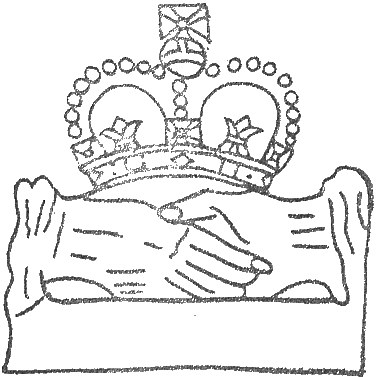
Plate 1a) Hand-In-Hand Fire-Mark
2. HAND-IN-HAND - Old Manor House, Bell Road, East Molesey - Lead mark - stamped 85151. This policy was first issued 11th February 1767, to Thomas Willett, tanner, and renewed in 1774 (43). The mark is on the main facade on the south side of the house. It cannot be seen from the public road. (Plate la).
3. HAND-IN-HAND - Chatley Farm, Pointers Road, Cobham - Lead mark - stamped 91005. This policy was issued on 30th September 1779, "on a house &c. situate on the East side of Birch Hill, about 2 miles south westward from Cobham, known by the name of Chatley Farm" (44).
4. SUN - Old Mill House, Stoke Road, Cobham - Lead mark - This mark has a number stamped on it which it has not yet been possible to decipher. (Plate 1b).

Plate 1b) Sun Fire-Mark
5. SUN - Pyports, Church Street, Cobham - Lead mark - This mark is on the rear of the house overlooking the lawn, and is numbered 676559. The policy was issued on 26th March 1795, to John Freeland, "on his new Dwelling house - near the Church, Cobbam", and for a farm house called "Marsh Place" and miscellaneous barns, etc. (45). (Plate lb).
6. SUN - Pyports, Church Street, Cobham - Lead mark - This mark is on the front of the house overlooking the road. It has a number stamped on it which it has not yet been possible to decipher. (Plate 1b).
7. SUN - Sunridge, 104 Hare Lane, Claygate - Lead mark - stamped 413756. This house was built in 1929. The mark, therefore, was not originally issued for this property. It was in fact, issued on 29th April 1779 covering a farmhouse at Broadway in Worcestershire (46). (Plate lb).
8. SUN - Plough P.H., Plough Lane, Cobbam - Lead mark - The number of this mark is completely obliterated. (Plate lb).
9. SUN - 66 Baker Street, Weybridge - Zinc plate - On west side of house. (Plate 2a).

Plate 2a) Sun Fire-Plate
10. UNION - Pyports, Church Street, Cobham - Lead mark - On rear of house overlooking lawn, not visible from public road. This mark is stamped 27663. Unfortunately the records of the Union have been lost and it is not possible to trace the issue of the insurance. It dates, however, from about 1770. (Plate 1c).
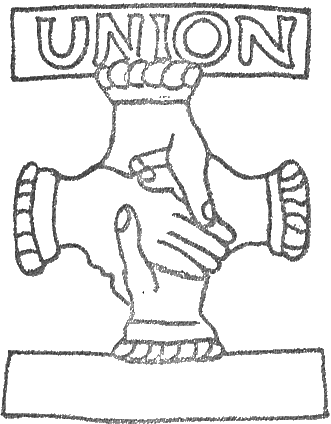
Plate 1c) Union Fire-Mark
11. ROYAL EXCHANGE - Chadworth,Hare Lane, Claygate - Lead.plate - This type of Royal Exchange plate, like the following four, was issued between about 1820 to 1890. (Plate 2b).

Plate 2b) Royal Exchange Fire-Plate
12. ROYAL EXCHANGE - 12 St. Leonards Road, Claygate - Lead plate. (Plate 2b).
13. ROYAL EXCHANGE - 28/30 Lower Green Road, Thames Ditton - Lead plate. (Plate 2b).
14. ROYAL EXCHANGE - 36 Lower Green Road, Thames Ditton - Lead plate. (Plate 2b).
15. ROYAL EXCHANGE - Kenwyn, Weston Green, Thames Ditton - Lead plate. (Plate 2b).
16. PHOENEX - The Orchard, Hare Lane, Claygate - Lead mark - stamped 1741. Unfortunately the old records of the Phoenix were destroyed by enemy action. It is, therefore, impossible to tell exactly when the policy was issued, but it would have been sometime between June and August 1782 (47). (Plate ld).
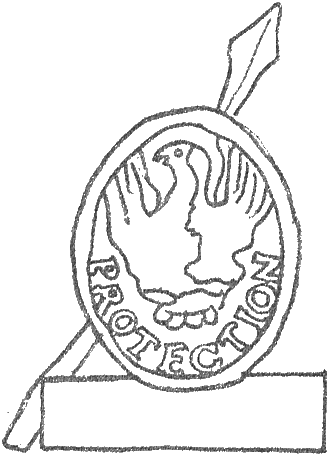
Plate 1d) Phoenix Fire-Mark
17. PHOENEX - 11/13 High Street, West Molesey - Copper mark - This mark originally had a number painted on it, now obliterated. (Plate ld).
18. PHOENEX - 41 Street Cobham - Copper mark - This mark had a number painted on it which is now obliterated. (Plate ld).
19. COUNTY - 16/18 Burwood Road, Hersham - Copper plate - This plate and the following were issued about 1808 - 1850. (Plate 2c).
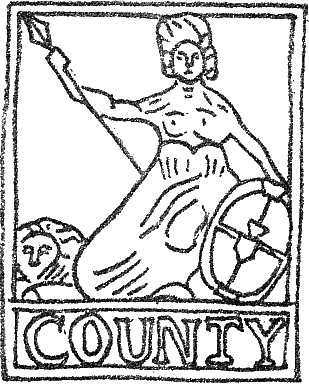
Plate 2c) County Fire-Plate
20. COUNTY - 14 Church Street, Walton-on-Thames - Copper plate. (Plate 2c).
21. COUNTY - 32 Bridge Road, East Molesey - Copper plate - This plate has no lower name-panel. (Plate 2c).
22. ROYAL - 28 Pemberton Road, East Molesey - Plate. (Plate 2d).
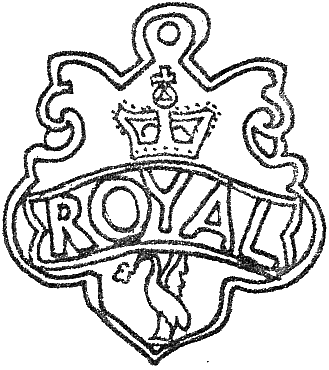
Plate 2d) Royal Fire-Plate
Besides the above the following houses displayed until recent times plaques which are now missing:-
23. North Weylands Farm, Walton-on-Thames. This house, likely to be demolished, had a SUN lead mark until the middle of last year. (Plate 1b).
24. 17 High Street, West Molesey. This house, now demolished, formerly had a SUN lead mark. (Plate lb).
25. 466 Walton Road, West Molesey. This cottage was demolished in 1969; a COUNTY copper plate from it is now in the possession of the Esher District Local History Society. (Plate 2c).
26. The Barley Mow, Molesey Road, Hersham. PHOENIX (Plate ld).
On the 12th November 1696 a number of enterprising individuals, whose names are still recorded, gathered together at Tom's Coffee House in St. Martin's Lane, and formed themselves into a society for the transaction of fire insurance business on a mutual basis "having for their sole object the benefit of the insured" (49). A Deed of Settlement was drawn up for the constitution and administration of the society which was signed by all the members (50). The society was given the rather ponderous title "The Contributors for Insuring Houses, Chambers or Rooms; from Loss by Fire by Amicable Contribution". This was later shortened to "The Amicable Contributors for Insuring from Loss by Fire", and still later to "The Amicable Contributionship" (51).
The society adopted as the emblem for its fire mark "Two hands clasped with a crown over them, a symbol of friendship and good faith and perhaps also intended as an indication of the mutual principle on which the society was founded" (52). Because of this it was not long before the society was affectionately known as "The Hand-In-Hand", and this was adopted as the official name of the company about 1706.
This emblem prompted William Cowper in his poem "Friendship", written in 1772, to compare friendship as being "Like Hand-In-Hand Insurance Plates" (53).
The society soon flourished and before long could claim that it was cheaper and better organised than either of its competitors (54). In January 1693 a permanent office was opened in Tom's Coffee House. This was kept until the 1720s, when the lease was taken over by a new company known as the Westminster (55).
The Hand-In-Hand was incorporated into the Commercial Union Group in 1905, but still continues in the mutual system laid down by its pioneers.
By the start of the eighteenth century three fire insurance concerns were operating, but these insured buildings only and not their contents. In 1699 an enterprise known as the Charitable Corporation was formed, which appears amongst other things, to have carried out some form of fire insurance on goods and furniture. It engaged "a competent number of watermen with coats and silver badges", also "carmen with carts and porters to help remove insured goods to any place desired". They also maintained warehouses, to which goods might be removed in case of fire and kept until the danger was passed, all free of cost to the insured (56).
This corporation seems to have lasted only a short time, but the idea was appropriated by Charles Povey, who had opened a general trading concern known as the Traders Exchange House. In 1706 Povey extended his business to cover fire insurance, specialising in "the insurance of goods and merchandise". He also carried the Corporation's other ideas a step further by proposing the formation of a Salvage Corps for the removal of goods in the case of fire and to protect them against theft (57).
In November 1708 Povey decided not only to extend the scope of his activities but also to bring some associates into the business which he renamed the Company of London Insurers (58).
In order to give some status to his new concern Povey wanted a fire mark like the older established offices. Having an interest in astronomy he chose what was to become perhaps the most famous fire mark of all - the sign of the resplendent Sun. "Every Person, who already has, or shall have at any time hereafter Subscribe to Mr. Povey's Proposals for Insuring Moveable Goods, Merchandizes and Wares, from Loss and Damage by Fire, shall have a Mark representing the Sun, nailed up against their Houses" (59).
In 1710 the business, like most of the other companies, dropped its more cumbersome title and adopted formally the nickname it had received from its fire mark emblem, and became known as the Sun Fire Office. It is now the oldest fire insurance company in the world still trading under its original name.
In 1714 a number of "respectable Merchants and Traders" issued proposals for forming a society to be known as the "Union Fire Office" (60), "for insuring goods and merchandises from loss by fire in the way and upon like terms with the Hand-In-Hand office, which is fairly calculated for the public good and not for the private advantage of any particular person" (61). The society was founded by a Deed of Settlement dated 16th February 1714 (62).
The constitution of the Union was firmly based on that of the Hand-In-Hand. From the start a strong relationship existed, and there were interlinking directorships between the two. The Union adopted as its fire mark a device, adapted from that of the Hand-In-Hand, representing four hands clasped. It was, therefore, often referred to as "The Double Hand-In-Hand". A working agreement was established between the two offices by which the Hand-In-Hand would only insure buildings and the sister office their contents (63). This provision lasted until 1805 (64).
The Union was merged with the Commercial Union in 1907.
The 'Weekly Journal' of 12th Dececieer 1719 records that "On Tuesday the Society of Gentlemen Subscribers of the new project for insurance of Ships and Merchandise waited upon the King with a petition for the Grant of a Charter to carry on their new undertaking, and we hear that they were graciously received and their Petition referr'd to the Privy Council". Their efforts were successful and they granted a royal charter in 1720. The company was first known as Onslow's Insurance from Lord Onslow its first governor. It began by dealing with marine insurance only. In 1721 a supplementary charter was obtained by the name of "The Royal Exchange Assurance of Houses and Goods from Loss by Fire", from the fact that their offices were sited in the Royal Exchange (65). The company also used a representation of the Royal Exchange building as the emblem on their fire mark. This was the old Royal Exchange build in 1669 after the Great Fire, and which was itself ravaged by fire in 1838. That fire unfortunately destroyed all the company's old records (66).
In the latter part of the eighteenth century the sugar bakers and refiners of London, because of the special fire risks of their business, found difficulty in obtaining insurance cover at moderate premiums from existing offices. They decided, therefore, in 1782, to promote a company themselves to cater mainly for their own particular risk (67). This company was called the New Fire Office, and, like the old Fire Office before it, adopted as a badge "a Phoenix Rising from the Flames". This was depicted on their fire mark together with the word "Protection". The company quickly flourished and the Phoenix is one of the most widely met of all fire marks.
This company was established in 1807 by an "association of noblemen end gentlemen" for the particular benefit of residents in country districts. The promoters adopted two provisions which were to have a great effect in advancing the popularity of the new office. The first, to encourage local growth, was the inauguration of county committees, on which members of the local gentry and other dignitaries were invited to sit. The second was that every person who continued his insurance for seven years under one policy could share in the profits of the office, without incurring liability for any of its losses. This was something new in a company other than a mutual society and "ensured the almost instantaneous success of the project" (68).
The fire-plate depicts Britannia with a shield of the Royal Arms as they were in 1807 bearing an inescutcheon of the arms of Hanover.
The County was absorbed into the Alliance (now the Sun Alliance and London Group) in 1906.
The Royal was established in Liverpool in 1945 and its fire-plate incorporates the crect of that city - cormorant (commonly known as the Liver Bird) with seaweed in its mouth (69).
(1) See - W.A. Bewes: Church Briefs or Royal warrants for Collections for Charitable Objects: 1896.
(2) Surrey Quarter Sessions Records: Vol.vi, Order Book and Sessions Rolls 1659-1661: Surrey County Council: l934: p.47.
(3) The Parish Registers of Sanderstead, Surrey: Surrey Parish Register Society: Vol.IV: 1908: p.42.
(4) W. Bruce Bannerman: The Parish Registers of Putney, Surrey: 1913: Vol. i, p.255.
(5) 19 Geo. IV, cap.42: An Act to abolish Briefs.
(6) W .W. Blackstock: The Historical Literature of Fire Insurance in Great Britain 1635-1810: 1910: pp.58/9.
(7) Dictionary of National Biography.
(8) T.F. Reddaway: The rebuilding of London after the Great Fire 1951: p.278.
(9) Stephen Wren: Parentalia, or Memoirs of the Family of Wrens: 1750: p.269.
(10) Francis Boyer Relton: An Account of the Fire Insurance Companies etc. in Great Britain and Ireland: 1893: p.20.
(11) This subject is fully discussed in - Harold E. Raynes: A History of British Insurance: 2nd edn. 1950: pp.78-82.
(12) Narcissus Luttrel: A Brief Historical Relation of State Affairs from September 1678 to April 1714: O.U.P.: 1857: Vol.1, p.l35, under date 13 October 1681.
(13) Blackstock: Op. Cit.: p.59.
(15) Mercurius Civicus: 12 May 1680: Quoted in Blackstock: p.62.
(18) Edward Baumer: The early days of the Sun Fire Office: 1910: p.5.
(19) P.G.M. Dickson: The Sun Insurance Office 1710-1960; 1960: p.69.
(20) Conflagrations are officially described as fires in which more than one property is involved. Walford lists 825 "great fires" in England alone between 1666 and 1876 - Cornelius Walford: The Insurance Cyclopaedia: 1871-8: Vol.iv: pp 43-110.
(21) Walford: Op. Cit.: Vol.IV; pp. 69-70.
(22) An Act for Preventing and Suppressing of Fires within the City of London and Liberties thereof.
(23) Bertram Williams: Fire Marks and Insurance Office Fire Brigades: 1927: p.67.
(25) 6 Anne, cap.58: An Act for the better preventing of mischiefs that may happen by fire: clause II.
(30) Percy Collins: A Chat about Fire-Marks: Quoted by G.A. Fothergill: British Fire-Marks: Edinburgh: 1911: p.5.
(31) See for instance G.V. Blackstone: A History of the British Fire Service: 1957: p.70.
(32) The Penny Magazine: 18 July 1840: Quoted by Mr. E.Nugent Linaker in the Bulletin of the Fire-Mark Circle: No.12, p.15.
(33) Information kindly given by the Sun Alliance and London Insurance Group, per Mr. W.E.H. Fuller, Archivist.
(34) Blackstone: Op. Cit.: p.89.
(35) 28&29 Vict., cap 90: An Act for the Establishment of a Fire Brigade in the Metropolis.
(37) Cecil T. Davis: Fire Insurance Wall Marks: in Fire and Water, Vol.xii, no.143, January 1896.
(43) Information kindly supplied by the Commercial Union Assurance Co. Ltd., per Mr. K.W. Benbow, Manager, Hand-In-Hand branch.
(44) Guildhall Library, MS 8674/122, fol.219.
(45) Information kindly supplied by the Sun Alliance and London Insurance Group; per Mr. W.E.H. Fuller, F.C.I.I., Archivist.
(47) Information kindly supplied by the Phoenix Assurance Company Limited; per Mr. G.M. Hayward, curator.
(48) In this section I have only described those companies and societies which have issued the marks and plates mentioned in the preceding section on local examples.
(49) The Hand-In-Hand Insurance Society: Bicentenary Notice: 1914: p.6.
(53) Southey's edn. of Cowper's Works: Vol.ix: p.328: Qutoed in Relton: p.77.
(55) Bryant Lillywhite: London Coffee Houses: 1963: pp.588-9.
(62) This date is Old Style, before the adoption of the Gregorian Calendar. We should call this 1715.
(63) Hand-In-Hand Bicentenary Notice: p.6.
(65) W.N. Whymper: The Royal Exchange Assurance. An Historical Sketch: 1896: p.9
(68) Aubrey Noakes: The County Fire Office 1807-1957: 1957: p.4.
Besides the authorities listed above, the following are the best books for the study of fire marks:-
1. Alwin B. Bulau: Footprints of Assurance: New York: 1953.
2. Bertram Williams: Specimens of British Fire-Marks: 1934.
The Fire Mark Circle exists for the encouragement of interest in and study of fire marks, The secretary is Mr. J.J. Williamson, 21 Winston Drive, Bexhill-On-Sea, Sussex.
A number of museums have collections of fire marks. The best in this part of the country are:-
1. The Chartered Insurance Institute, Aldermanbury, E.C.2.
2. The Guildhall Museum, Basinghall Street, E.C.2.
All books copyright © R G M Baker, all rights reserved.
Images © 2006 M J Baker and S A Baker, all rights reserved.
Web page design © 2006 M J Baker and S A Baker, all rights reserved.